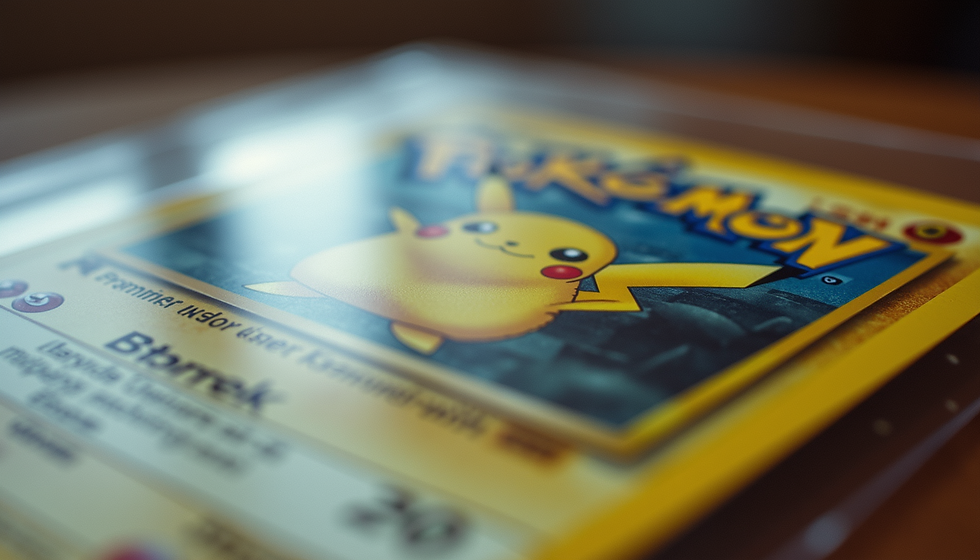How to Authenticate Rare Pokémon Cards: A Guide to Spotting Counterfeits and Verifying Authenticity
- Celestrion-TCG

- May 30
- 3 min read

Introduction
Learning how to authenticate rare Pokémon cards is essential for protecting your collection and investment. This process involves verifying a card's genuineness through visual inspection, physical checks, and professional services.
As Pokémon card popularity surges, so does the production of counterfeits. With high-value sets and individual cards drawing significant attention, counterfeit activities have become more sophisticated. Therefore, employing reliable authentication techniques is crucial to avoid financial losses and maintain the integrity of your collection. Discover the best trading card games to invest in.
Counterfeit concerns amplify the need for rigorous verification processes. Such methods are indispensable tools for those passionate about Pokémon card collecting, ensuring each card’s authenticity and worth. Learn more about identifying rare Pokémon cards and investment tips. Discover insights on detecting fake Pokémon cards.
Understanding Pokémon Cards
Pokémon cards are celebrated collectibles with significant investment potential. Rare or vintage cards can command high prices, thereby becoming targets for counterfeiters.
Key factors that determine a card's value include rarity, physical condition, the set it belongs to, and its historical significance. These factors make understanding the basics of identification paramount in learning how to authenticate rare Pokémon cards. Explore Pokémon card classifications and their values. Discover guide to rarity scales and tips for Pokémon card investments. Top Pokémon cards to buy for investment.
Common Counterfeits
Spotting counterfeit trading cards starts with an awareness of common fake characteristics such as subpar fonts, color mismatches, and incorrect holographic effects. Counterfeit Pokémon cards are alarmingly prevalent in the market, introducing significant financial risks ranging from minor monetary losses to acquiring worthless forgeries at exorbitant prices. High demand sets are particularly targeted by counterfeiters.
Spotting Counterfeit Trading Cards
Visual Inspection
Print Quality and Color Accuracy: Genuine cards offer crisp and vibrant printing. Look for precise text and sharp colors; counterfeits may appear dull or blurred.
Holofoil Patterns: Complex holofoil designs on real cards are challenging to replicate. Examination of holographic areas can reveal inconsistencies in fakes.
Comparison: Compare questionable cards with verified genuine ones for differences in color saturation, text clarity, and print quality.
Physical Characteristics
Card Weight and Material: Authentic Pokémon cards have a consistent feel and thickness. Counterfeits might feel unusually stiff, thin, or flexible.
Alignment and Cut: Real cards possess even borders and smooth edges, whereas fakes may be unevenly cut.
Flashlight Method: Shining a flashlight through the card can reveal an inner layer in genuine cards that fakes lack.
TCG Card Forensics Authentication
TCG card forensics authentication employs scientific methods like magnification, UV light, and X-ray analysis to determine a card's legitimacy.
Professional grading services, such as PSA and Beckett, offer expert reviews, official grading, and tamper-proof casing, adding credibility to high-value cards. Forensic authentication involves detailed visual, physical, and sometimes chemical analysis, culminating in an official certification. Explore the best trading card grading companies.
Verifying Vintage Card Authenticity
Verifying vintage card authenticity can be complex due to variations in early print techniques or materials.
Research the Specific Set/Year: Collectors are advised to consult resources like Pokellector to delve into set specifics, card details, and historical aspects.
Provenance: Where possible, tracing ownership history is vital in confirming authenticity.
Community Insights: Leverage collector databases and forums to compare card details, with expert opinions often proving invaluable.
Additional Tips for Buyers and Sellers
Trusted Marketplaces: Use reliable dealers and platforms with established authentication procedures.
Professional Grading: Request certification or professional grading for high-value cards. Explore the best trading card grading companies.
Engage with Communities: Joining Pokémon card forums and groups provides support for spotting counterfeit trading cards. Join TCG trading and meetups near you.
Safe Transactions: Safeguard transactions with return policies or seller guarantees.
Conclusion
Successfully learning how to authenticate rare Pokémon cards involves a combination of visual and physical checks, TCG card forensics authentication, and verifying vintage card authenticity. By mastering steps like analyzing print quality and consulting professional services, collectors can ensure their treasures are genuine.
Have you encountered fake cards, or do you seek advice on spotting counterfeit trading cards? Share your experiences and questions in the comments, aiding others in strengthening their collections.
Related Resources
Bookmark these resources and engage with expert communities to remain vigilant against counterfeits.




Comments